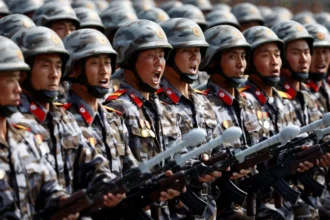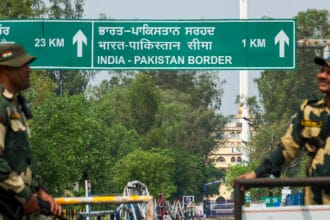Heavy Rainfall in Mumbai and Bengal: It’s mid-May. The air feels thicker. The birds, usually chirping well into the morning, have gone quiet earlier than usual. And across much of India, eyes are shifting skyward, waiting, hoping—or dreading—the rumble of clouds.
This isn’t just another seasonal change. The Indian Meteorological Department (IMD) has sounded the alarm. Heavy rains are about to wash across the western coasts and the eastern plains. From the ever-bustling Mumbai streets to the quiet rice paddies of rural Bengal, change is coming—and fast.
Mumbai: Between Asphalt and Ocean
Let’s start with Mumbai.
People here have a complicated relationship with the rain. On one hand, the monsoon brings relief from the relentless summer heat; on the other, it cripples the city. Local trains run late, streets turn into rivers, and umbrellas become both a shield and a struggle.
This week, a new weather system is brewing off the Karnataka coast—a cyclonic circulation forming over the Arabian Sea. IMD says it may evolve into a low-pressure area by May 22. That may sound harmless, but seasoned Mumbaikars know it’s the prelude to downpours, power cuts, and flash floods.
Sanjay Jadhav, a delivery executive for a food delivery app, sighs as he zips up his raincoat. “Abhi toh shuruaat hai,” he says. “If it gets worse, I don’t know how I’ll manage on the bike.” He’s not alone. Daily wage workers, cab drivers, and even office-goers are all bracing for what’s to come.
The city’s civic body claims to have cleaned drains and pumped out low-lying areas. But it’s Mumbai. You never really know.
Delhi: Dancing on the Edge of a Storm
Then there’s Delhi. The city is choking under a heatwave, with temperatures soaring above 41°C. It’s the kind of heat that sticks to your skin and steals your energy before noon.
But change is on the horizon.
According to IMD, thunderstorms with light to moderate rainfall are expected mid-week. Winds may whip through the city, offering brief but welcome respite.
Ankita Mehra, a school teacher in Dwarka, is cautiously optimistic. “The heat is unbearable. Even the fans feel like they’re blowing hot air. A little rain would be a blessing. But too much? Well, the city’s drainage can’t handle that either.”
Delhi’s forecast calls for minimum temperatures around 28°C, and maximums peaking just under 40°C. The capital may not be facing a deluge like Mumbai or Bengal, but sudden storms can disrupt flights, traffic, and power supply just as easily.
West Bengal: When the Wind Whispers Warnings
In Bengal, it’s a different story.
Northern districts are preparing for intense rain, while the southern parts, including Kolkata, are under thunderstorm watch. The culprit? A cyclonic circulation over Bangladesh paired with moist winds from the Bay of Bengal.
Fields that just saw planting are now at risk of flooding. For farmers like Anup Mondal in Cooch Behar, it’s a time of nervous waiting. “Boro season just ended,” he says. “We hoped for light rain. But if this turns into heavy showers, we’ll lose our saplings.”
That’s the emotional cost of uncertain weather—not just flooded roads or lost umbrellas, but potential livelihood damage for millions.
Kolkata’s beautiful skyline, its colonial-era buildings, and bustling bazaars might soon be wrapped in a sheet of rain. While the city handles moderate rain well, a prolonged system can cause waterlogging in its older neighborhoods.
A Bigger Picture: Why This Matters More Than Ever
This isn’t just a story about a few rainy days. It’s about unpredictability. Every year, India is experiencing sharper shifts in weather patterns. A heatwave here, unseasonal rain there, and now, potentially stronger pre-monsoon systems.
Climate experts have warned that rising sea surface temperatures are feeding the power of these cyclonic circulations. That means more intense storms, shorter warning periods, and wider damage.
Dr. Neha Shinde, a climatologist based in Pune, explains:
“We used to get clearer patterns before. But now, the monsoon onset, intensity, and withdrawal are all harder to predict. It’s like the climate is no longer playing by the rules.”
It’s not just about inconvenience anymore. These weather patterns directly affect agriculture, health, and the economy. Crops get washed out, water-borne diseases spread, and cities scramble to fix cracked infrastructure.

For more updates and other exciting news, visit our website now!
From Streets to Screens: How People Are Preparing
Social media is already buzzing. Memes of people in boats during traffic jams, jokes about working from “rain offices,” and plenty of anxious updates on train cancellations.
But underneath the humor is a shared nervousness.
Many are preparing quietly—charging power banks, buying groceries in bulk, and refolding the tarps they had packed away last year. Schools in parts of Bengal and Maharashtra are keeping a close watch on announcements. Offices in Mumbai may switch to remote work for safety.
And then there are the unsung heroes—sanitation workers, traffic police, disaster response teams—already on alert.
In Conclusion: The Rain Will Come, Are We Ready?
This is the reality of life in a country where the weather can change the course of your day—or your entire season—in a matter of hours.
For now, all we can do is wait. Wait for the sky to break open. Wait for the first drops to fall. And hope that, this time, we’re a little more prepared, a little more resilient, and a little more understanding of the power that nature holds.
Because when the rain comes—and it will—it doesn’t knock. It pours.
















